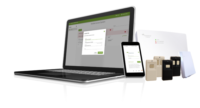Roughly two million Americans are victims of workplace violence every year according to a U.S. Department of Labor Statistics survey. While it is difficult to entirely eliminate the threat of violence in the workplace, there are measures that can greatly reduce the risk. The ability to effectively locate and communicate accurate information in times of crisis is of the utmost importance. When dealers and integrators look into options for securing their customer’s buildings, the typical systems of choice will fall under intrusion, access control or video. While each of these solutions are highly effective when used in the appropriate settings, there is an increasing need for a security solution that goes beyond building security to one that is arguably more important and helps protect human lives. This is evident especially within the healthcare industry. According to the Center for Personal Protection and Safety, “healthcare professionals are 16 times more likely to be attacked on the job than any other service professionals.” Security system dealers and integrators are being tasked with determining a solution that helps staff members both feel safer in their work environment and become proactive about their personal security as well as those around them.
Today, dealers and integrators can leverage an enterprise mobile duress system for increased employeeprotection. With the right type of system, an employee can send an alarm, and, with the simple push of a button, appropriate responders will immediately receive the alert. This not only helps responders become aware of the situation quickly, but with the help of the enterprise mobile duress system, they can pinpoint the location of the person or people in danger. An enterprise mobile duress system can also be prompted to notify people in the area of a potential danger through a variety of devices including phones, pagers and alerting systems. With such a system in place and proper training of employees, commercial facilities are able to integrate with and extend their existing physical security measures to include people protection system as well. Some systems can even extend coverage and location abilities into parking lots and stairwells, offering another layer of protection for employees who carry mobile duress pendants. With these key features in mind, it is important to take a closer look at key requirements for enterprise mobile duress systems that make people protection possible.
Location
An enterprise mobile duress system should be able to identify the location of a person or people in distress. In many work environments, employees are mobile and can travel from one location to a completely different wing of a building within just a few minutes. Because of this, it is critical for a system to provide the location of a distressed individual with enough accuracy to find the impacted person/people as quickly as possible. It also is important to select the appropriate location technology. An enterprise mobile duress system must have a wireless location technology that is fit for purpose both inside and outside of a building.
Notification
An enterprise mobile duress system must be able to alert responders to ensure a rapid response. In many facilities, security staff and other responders are unlikely to be in the same location at all times. In the worst case scenario, such as an active shooter, security responders may be across campus and need to be notified no matter where they are located. Additionally, an enterprise mobile duress system should not only have the ability to utilize a large variety of devices for mass notification, but also should be flexible in that it has the ability to notify as many or few people as needed depending on the situation.
Wireless Technologies
The single most important requirement for an enterprise mobile duress system is a fit for purpose wireless network. The wireless network needs to reliably send a signal through difficult building construction and environments that may present obstacles for RF signals. An enterprise mobile duress system also should be able to ensure every employee can have access to a mobile panic button pendant if necessary. Dealers and integrators should look for a wireless technology with the scalability to handle potentially thousands of pendants and the flexibility to cover an entire facility or campus. Not all wireless technologies are created equal, which is why a fit for purpose wireless network should be carefully evaluated and selected.
Conclusion
While it is virtually impossible to prevent all incidents of workplace violence, security dealers and integrators must be aware of solutions that end users can use to protect their staff as well as other innocent people within their facilities. By properly deploying an enterprise mobile duress system and training staff on how to use pendants and/or panic buttons, facility administrators can be assured that responders will accurately locate the crisis situation and respond in the most efficient and effective way possible.
For an example of an enterprise mobile duress system at work, read “S.D. Hospital Campus Protects Employees With Enterprise Mobile Duress” in the Tech at Work section of sdmmag.com.
About the Author
Mark Jarman is president of Inovonics (www.inovonics.com), a provider of enterprisemobile duress and wireless sensor networks based in Louisville, Colo. You can contact Jarman at mark.jarman@inovonics.com.






